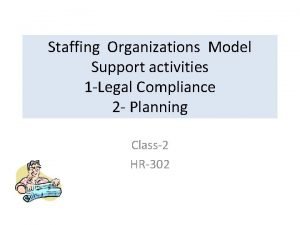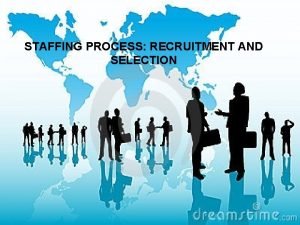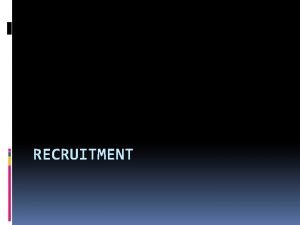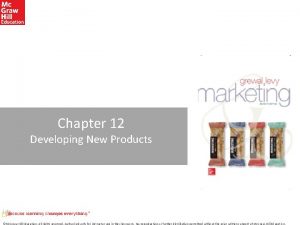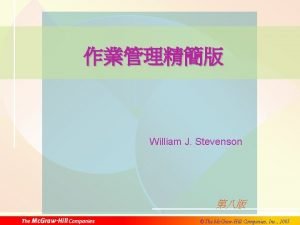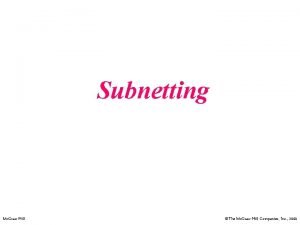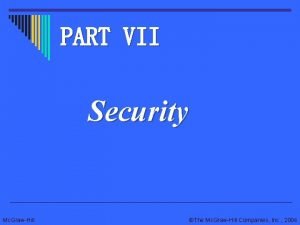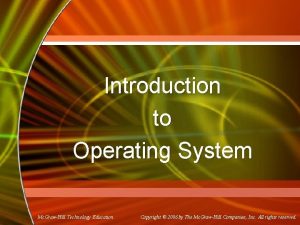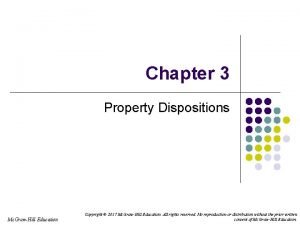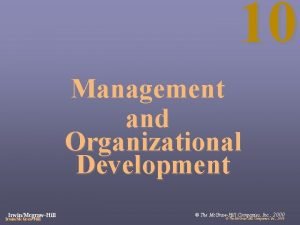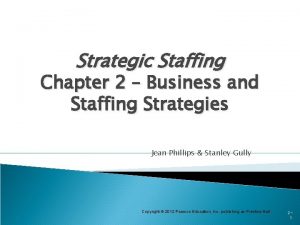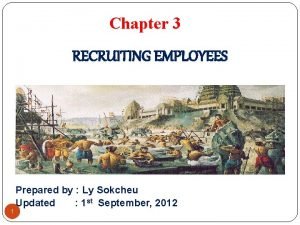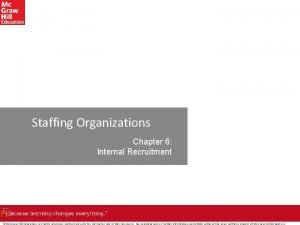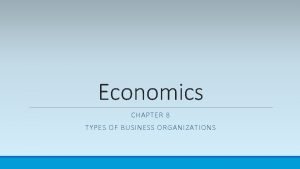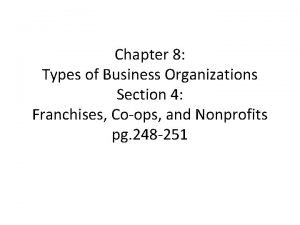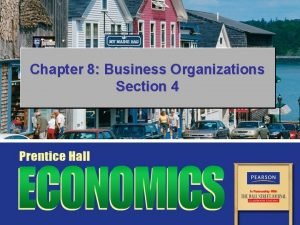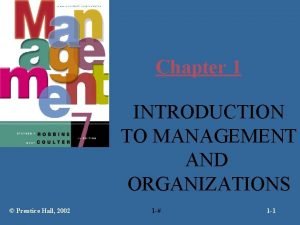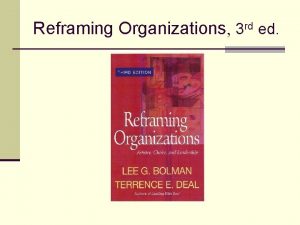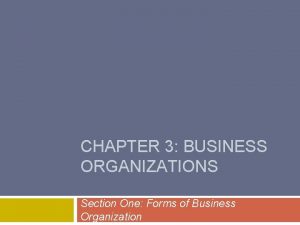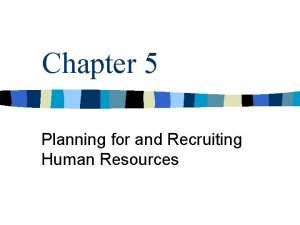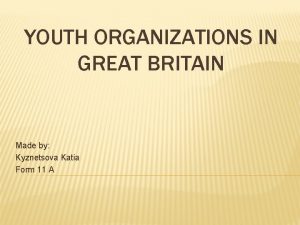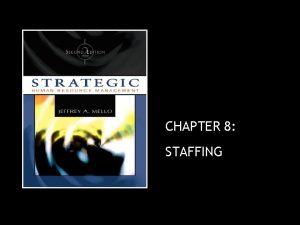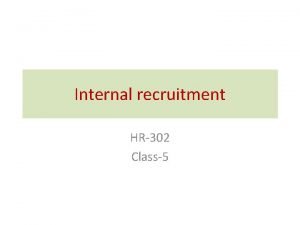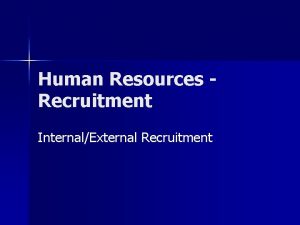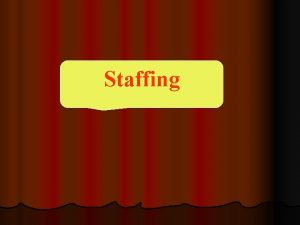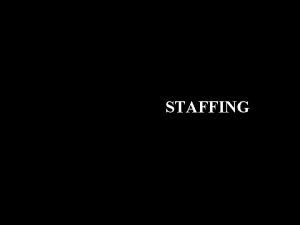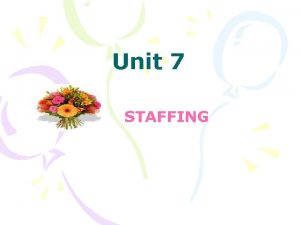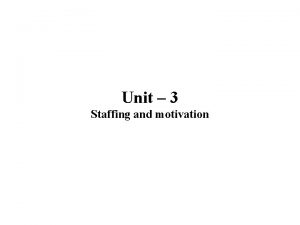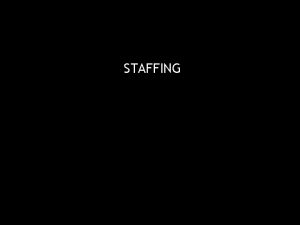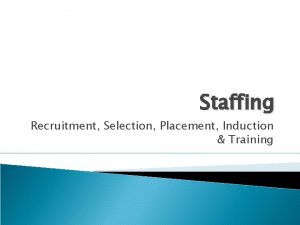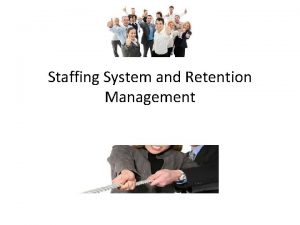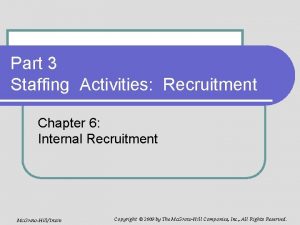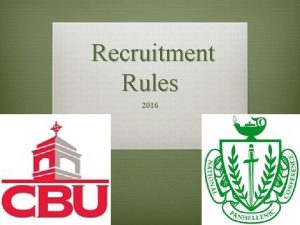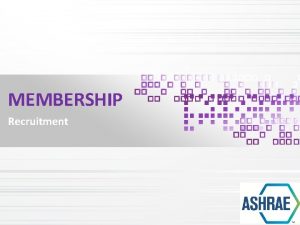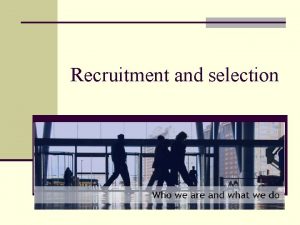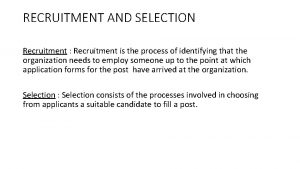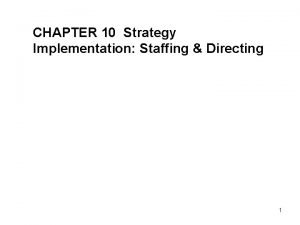Staffing Organizations Chapter 6 Internal Recruitment Mc GrawHill




























- Slides: 28

Staffing Organizations Chapter 6: Internal Recruitment ©Mc. Graw-Hill Education. All rights reserved. Authorized only for instructor use in the classroom. No reproduction or further distribution permitted without the prior written consent of Mc. Graw-Hill Education.

Learning Objectives for Chapter 6 • Be able to engage in effective internal recruitment planning activities • Apply concepts of closed, open, and hybrid recruitment to the internal recruiting process • Recognize which recruitment sources are available for internal candidates • Evaluate internal recruiting based on established metrics • Be able to evaluate communication messages for internal selection • Recognize how applicant reactions influence the effectiveness of a recruiting plan • Understand how affirmative action plans are implemented for internal recruiting ©Mc. Graw-Hill Education.

Internal Recruitment Strategic Recruitment Planning ©Mc. Graw-Hill Education

Hierarchical Mobility Paths ©Mc. Graw-Hill Education. Jump to Hierarchical Mobility Paths, Appendix

Alternative Mobility Paths Jump to Alternative Mobility Paths, Appendix ©Mc. Graw-Hill Education.

Example Ways to Make Work Meaningful • When upward mobility is limited by alternative mobility paths, special steps need to be taken to ensure that work remains meaningful – Alternative reward systems – Team building – Counseling – Alternative employment ©Mc. Graw-Hill Education.

Characteristics of a Mobility Path Policy • Intent of policy is clearly communicated • Policy is consistent with philosophy and values of top management • Scope of policy is clearly articulated • Employees’ responsibilities and opportunities for development are clearly defined • Supervisors’ responsibilities for employee development are clearly stated • Procedures are clearly described • Rules regarding compensation and advancement are included • Rules regarding benefits and benefit changes are included ©Mc. Graw-Hill Education.

Recruitment Planning: Administrative Issues • Requisitions • Coordination between internal and external efforts – Establish internal staffing specialist positions (placement/classification professionals) to ensure consideration of internal candidates – Create policies specifying number and types of candidates sought both internally and externally • Budget ©Mc. Graw-Hill Education.

Strategy Development: Closed Recruitment • Definition – Employees are not informed of job vacancies • Advantages • Disadvantages Jump to Strategy Development: Closed Recruitment, Appendix ©Mc. Graw-Hill Education.

Strategy Development: Open Recruitment • Definition – Employees are made aware of job vacancies – Job posting and bidding system • Advantages • Disadvantages Jump to Strategy Development: Open Recruitment, Appendix ©Mc. Graw-Hill Education.

Choosing Among Open, Closed, and Hybrid Internal Recruiting Technique Open Advantages Identifies more candidates, including those who might be overlooked in a closed system Makes rules and regulations explicit and open to all employees Sometimes required by labor agreements • • Less expensive in terms of search costs Offers a quicker response Less cumbersome when only a select few meet the minimum requirements • • • Finds a large number of candidates Everyone has an opportunity to apply • • Closed Hybrid ©Mc. Graw-Hill Education. Best When • • • Issues exist about perceived fairness Hidden talent might be overlooked Managers need the new candidate to start immediately Jobs require a very narrow and specialized set of KSAOs Adequate resources are available to run the such a complex system Jobs are especially key to organizational success

Discussion Questions • Traditional career paths emphasize strict upward mobility within an organization. How does mobility differ in organizations with alternative career paths? List three alternative career paths discussed in this chapter, describing how mobility occurs in each. ©Mc. Graw-Hill Education.

Internal Recruitment Applicant Reactions ©Mc. Graw-Hill Education

Applicant Reactions • Minimal research regarding reactions of applicants to internal recruitment process • Perceived fairness – Distributive justice - Perceived fairness of actual decision – Procedural justice - Perceived fairness of process (policies and procedures) ©Mc. Graw-Hill Education.

Internal Recruitment Communication ©Mc. Graw-Hill Education

Searching: Communication Message • Realistic – Different for internal applicants – May be needed for unknown or newly created jobs • Targeted – Focus on job rewards matrix ©Mc. Graw-Hill Education.

Searching: Communication Medium • Job posting • Other written documents – Brochures – Videocassettes – Diskettes • Potential supervisors and peers • Informal systems ©Mc. Graw-Hill Education.

Discussion Questions • What information should be included in the targeted internal communication message? ©Mc. Graw-Hill Education.

Internal Recruitment Strategy Implementation ©Mc. Graw-Hill Education

Strategy Development: Recruitment Sources • Job posting • Intranet and intraplacement • Talent management system • Nominations • In-house temporary pools • Replacement and succession plans • Career development centers ©Mc. Graw-Hill Education.

Talent Management System • Comprehensive method for monitoring and tracking employee skills and abilities – Identify the KSAOs required for all jobs – The complete set of KSAOs is compiled into a master list. – The current workforce will need to be assessed for its competence in this set of KSAOs – When positions come open, managers make a query to the talent management system to determine which employees are ready to come into open positions. • Often coupled with specific human resources information systems (HRIS) to facilitate tracking KSAOs in the workforce ©Mc. Graw-Hill Education.

Career Development Centers • Provide employees with opportunities to take interest inventories, assess their personal career goals, and interview with representatives across the organization • Can be an effective retention tool for employees who desire a change, but the cost is often very high so ROI should be assessed regularly ©Mc. Graw-Hill Education.

Metrics for Evaluating Recruiting Methods • Quantity • Quality • Cost • Impact on HR Outcomes – Employee satisfaction – Job performance – Diversity – Retention ©Mc. Graw-Hill Education.

Internal Recruitment Legal Issues ©Mc. Graw-Hill Education

Legal Issues • Affirmative Action Programs Regulations – Suggestions to ensure equal opportunity for females and minorities • Bona fide seniority systems – Law permits use of seniority systems if they are not the result of an intention to discriminate – Issues • Law does define term “seniority system” • Absent discriminatory intent, a seniority system is likely to be bona fide, even if it causes adverse impact ©Mc. Graw-Hill Education.

Legal Issues: Glass Ceiling—Overcoming Barriers • Examine the organizational culture • Drive change through management commitment • Foster inclusion • Educate and support women in career development • Measure for change ©Mc. Graw-Hill Education.

Discussion Question • Exhibit 6. 9 contains many suggestions for improving the advancement of women and minorities. Choose three suggestions you think are most important and explain why. ©Mc. Graw-Hill Education.

Ethical Issues in Staffing • Issue 1 – Let’s say a company called MDN Inc. is considering two employees for the job of senior manager. An internal candidate, Julie, has been with MDN for 12 years and received very good performance evaluations. The other candidate, Raoul, works for a competitor, and has valuable experience in the product market into which MDN wishes to expand. Do you think MDN has an obligation to hire Julie? Why or why not? • Issue 2 – Do organizations have an ethical obligation to have a succession plan in place? If no, why not? If so, what is the ethical obligation and to whom is it owed? ©Mc. Graw-Hill Education.
 Staffing organizations model
Staffing organizations model Recruitment policy meaning
Recruitment policy meaning External sources of recruitment images
External sources of recruitment images Grawhill
Grawhill Grawhill
Grawhill Grawhill
Grawhill Grawhill
Grawhill Mc graw hill
Mc graw hill Single user multitasking os
Single user multitasking os Grawhill
Grawhill Mc grawhill
Mc grawhill Grawhill
Grawhill Staffing strategy/strategies
Staffing strategy/strategies Advantage of external recruitment
Advantage of external recruitment Selection introduction
Selection introduction Chartwell staffing jobs
Chartwell staffing jobs Advantages of external sources of recruitment
Advantages of external sources of recruitment Recruitment objectives
Recruitment objectives Chapter 8 types of business organizations
Chapter 8 types of business organizations Section 4 other organizations
Section 4 other organizations Chapter 8 business organizations
Chapter 8 business organizations Introduction to management chapter 1
Introduction to management chapter 1 Reframing organizations chapter 3 summary
Reframing organizations chapter 3 summary Chapter 3 information systems organizations and strategy
Chapter 3 information systems organizations and strategy Chapter 3 business organizations
Chapter 3 business organizations What are the 7 principles of internal control
What are the 7 principles of internal control Internal control and internal check
Internal control and internal check Chapter 5 planning for and recruiting human resources
Chapter 5 planning for and recruiting human resources Youth organizations in great britain
Youth organizations in great britain
